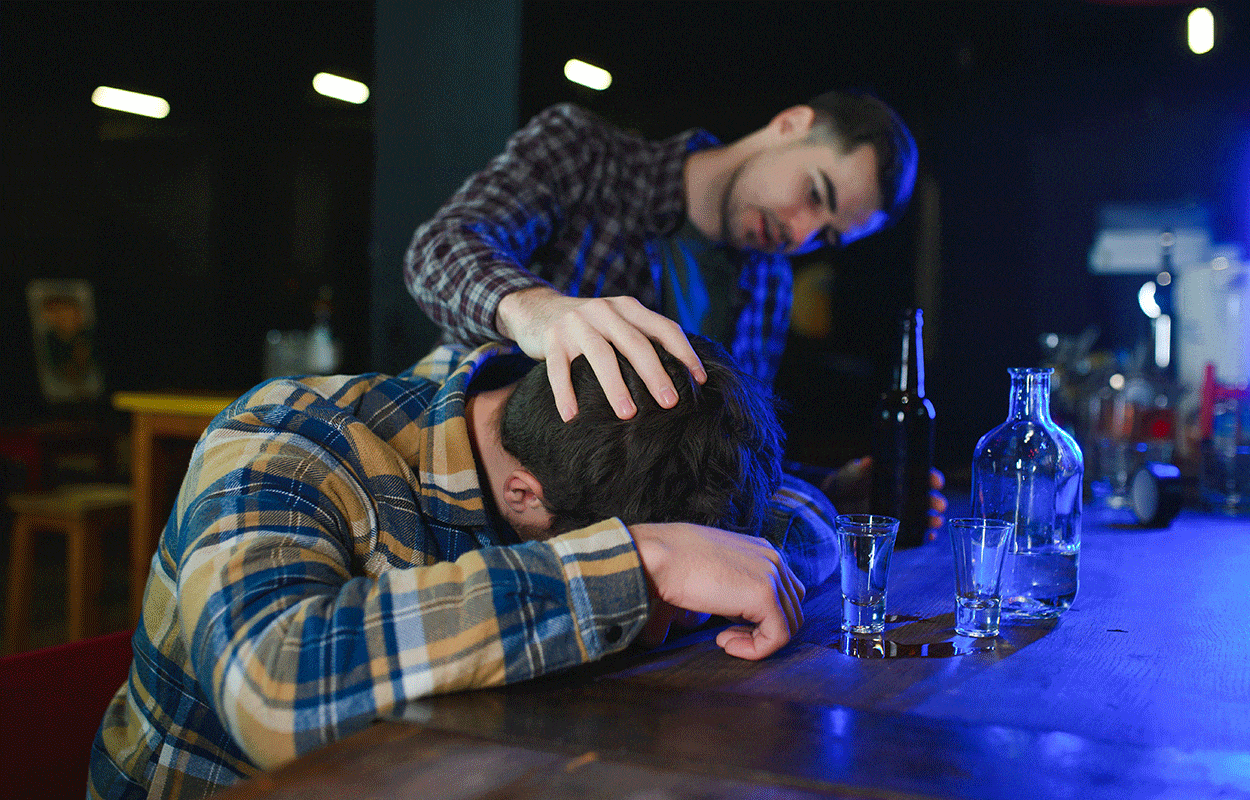The Professions With Highest Alcoholism Rates

Key Points
- Occupational stressors such as long hours and stressful working conditions may contribute to heavy alcohol use.
- Miners, construction workers, food service workers, arts and entertainment professionals, and utility workers have the highest rates of alcohol abuse.
- Alcohol use disorder is a public health issue, causing over 175,000 deaths in the United States each year.
- Signs of alcohol use disorder include intense cravings for alcohol, building tolerance for alcohol, and experiencing withdrawal symptoms when not drinking.
- If you have alcohol use disorder, experts recommend seeking professional assistance, as detoxing on your own can be dangerous and even deadly.
- Treatment for alcohol use disorder may include medical detox, behavioral therapy, and relapse prevention.
Professions With Highest Alcoholism Rates
Professions with the highest rates of heavy alcohol use include miners, construction workers, food service workers, arts and entertainment professionals, and utility workers. Heavy drinking is 8 or more or 15 or more drinks per week for women and men, respectively.
Many people in the U.S. find themselves battling alcohol use disorder, and quitting can be challenging. People with signs of alcohol use disorder can safely detox and recover in a rehabilitation treatment center.
What Profession Has the Highest Rate of Alcoholism?
The prevalence of alcohol abuse among U.S. workers poses a threat to the economy and public health. It’s estimated that American companies lose billions of dollars every year due to substance use, including alcohol misuse. Employees who are heavy drinkers aren’t as productive, have high rates of absenteeism, and become sick or injured more often.
The Substance Abuse and Mental Health Services Administration (SAMHSA) sought to better understand patterns of alcohol use in different industries across the country. To accomplish this, they designed and administered the National Survey of Drug Use and Health to employees in various occupational sectors. Results of the survey provide insight on the professions with the highest rates of heavy alcohol use. SAMHSA found that workers in the following five industries reported the highest rates of problematic drinking: mining, construction, food service, arts and entertainment, and utilities.
Miners
According to data from the Substance Abuse and Mental Health Services Administration (SAMHSA) and the National Survey on Drug Use and Health, miners have the highest rates of alcohol use. SAMHSA found that 17.5% of mining workers used alcohol heavily in the month prior to the survey. [1] The survey did not collect information about the reasons workers in the mining industry had for consuming excessive amounts of alcohol. There could be many factors at play. For instance, the Bureau of Labor Statistics (BLS) reports that many miners work long hours, often exceeding 40 hours per week. [2] This, combined with the dangerous nature of the job, could cause some workers to turn to alcohol for stress relief.
Construction Workers
According to the SAMHSA report, construction workers consume nearly as much alcohol as miners. Among workers aged 18-64 in the construction industry, 16.5% reported heavy drinking in the past month. [3]The reason for their higher rates of alcohol abuse is unknown. However, the U.S. Bureau of Labor Statistics reports that working conditions for construction laborers and helpers are challenging. [4] They may work irregular hours, and their work is physically demanding. Often, they work in undesirable weather conditions, in confined spaces, and at extreme heights.

Food Service Workers
Problem drinking is also prevalent among food service workers. SAMHSA reports that over 11% of workers in the food service industry drank heavily in the month prior. [5] Although it’s impossible to know specific reasons for binge drinking among individuals, some occupational risk factors exist for this type of work.
In addition to low wages and irregular work hours, food service workers may be responsible for serving alcoholic drinks or working in environments where other people are engaging in heavy alcohol use. The work environment may be especially impactful for bartenders, who make up a substantial portion of the workforce in this industry. Food service workers in general may have easy access to alcohol, which could contribute to a drinking problem over time.
Arts and Entertainment
Workers in the arts and entertainment industry also report higher rates of alcohol use. SAMHSA reports that 11.5% of these workers drank heavily in the previous month. [6] While it’s impossible to say exactly why, work-related factors could be to blame. For example, musicians and singers are often exposed to alcohol and drug use during and after their performances. For some of these performers, drinking is part of their lifestyle.
Utility Workers
Compared to the general population, utility workers also report higher rates of heavy drinking. Over 10% of those surveyed reported heavy alcohol use in the past month. [7] Like construction workers, utility workers often work in dangerous work environments. They may have to work with live wires and at great heights, for instance. The high-stress nature of their work may compel them to turn to alcohol or other substances for relief.
Understanding Problem Drinking
The employees in the industries mentioned above aren’t alone. Heavy drinking (more than 8 drinks for women or 15 drinks for men per week) has become a public health issue in the United States. According to the Centers for Disease Control and Prevention (CDC), roughly 17% of the U.S. population reports binge drinking, and 6% drink heavily. [8] Binge drinking refers to the number of drinks consumed in a single occasion, typically 4 for women and 5 for men.
Both binge drinking and heavy alcohol use are dangerous habits that can lead to health problems, risky behaviors, and alcohol use disorder. If you’ve tried to quit drinking or limit the amount you drink and have been unsuccessful, it may be a sign to reach out for professional help. Admitting you have a drinking problem is an act of bravery, not a sign of weakness.
Health Risks of Alcohol Misuse
An estimated 178,000 Americans die from excessive alcohol consumption each year. These deaths are attributable to a number of alcohol-related health conditions, including: [9]
- Cirrhosis of the liver
- Cerebellar degeneration
- Alcohol poisoning
- Alcohol-induced cardiomyopathy
- Alcohol-induced hepatitis
- Delirium tremens
Signs of Alcohol Use Disorder
If you think you or a loved one might have a problem with alcohol, there are some signs to watch for. Signs of an alcohol addiction or alcohol use disorder may include: [10]
- Unsuccessful attempts to quit drinking or limit the amount of alcohol consumed
- Strong alcohol cravings
- Continued drinking despite it causing problems with relationships or at work/school
- Dangerous or risky alcohol use, such as drunk driving
- Giving up activities to continue drinking
- Spending a lot of time either drinking or recovering from alcohol use
- Needing more alcohol to achieve the same level of inebriation (i.e., building a tolerance).
- Experiencing withdrawal symptoms after abstaining from alcohol for a period of time (i.e., developing a physical dependence)
Getting Help for Alcohol Use Disorder
Some people with alcohol use disorder try to quit on their own, but this isn’t recommended. People who drink heavily or have been using alcohol for a long period of time may experience serious or life-threatening withdrawal symptoms if they stop using alcohol abruptly. It’s best to seek guidance and assistance from a professional.
Alcohol Withdrawal Symptoms
If you’ve developed a physical dependence on alcohol, you’ll experience withdrawal symptoms when you stop using it. Some of the withdrawal symptoms linked to alcohol use include: [11]
- Anxiety
- Insomnia
- Increased heart rate
- Seizures
- Delirium
- Upset stomach
- Sweating excessively
- Blood pressure spikes
- Heart palpitations
- Confusion
- Increase in body temperature
- Hallucinations
- Headache
- Tremor
The risk of severe alcohol withdrawal may be higher for people who drink daily, are over the age of 65, or have certain medical conditions. You can prevent withdrawal from alcohol by avoiding alcohol altogether or seeking help for an alcohol use disorder.
Risk Factors for Alcohol Withdrawal
Alcohol withdrawal can be dangerous, and in some cases, life-threatening. It’s recommended that you detox from alcohol under the supervision of a health care provider. Despite this recommendation, many people try to quit drinking on their own. It’s important to know the risk factors for dangerous alcohol withdrawal: [12]
- Drinking heavily on a daily basis
- Having abnormal liver function
- Being over the age of 65
- Having electrolyte imbalances
- Being dehydrated
- A history of delirium tremens or alcohol withdrawal seizures
- Brain lesions
Ask About Treatment Options
If you or a loved one is displaying signs of alcohol use disorder, there is help available. Alcohol detoxification is safer in a medically supervised environment. After detox, other services are available to help you safely discontinue alcohol use and remain committed to sobriety. There’s reason to hope for a brighter future.




